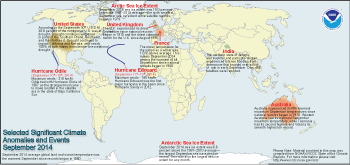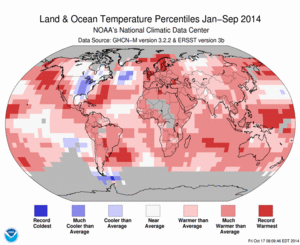Use the form below to select from a collection of monthly summaries recapping climate-related occurrences on both a global and national scale.
Global Climate ReportSeptember 2014
Global Highlights
- The combined average temperature over global land and ocean surfaces for September 2014 was the highest on record for September, at 0.72°C (1.30°F) above the 20th century average of 15.0°C (59.0°F).
- The global land surface temperature was 0.89°C (1.60°F) above the 20th century average of 12.0°C (53.6°F), the sixth highest for September on record. For the ocean, the September global sea surface temperature was 0.66°C (1.19°F) above the 20th century average of 16.2°C (61.1°F), the highest on record for September and also the highest on record for any month.
- The combined global land and ocean average surface temperature for the January–September period (year-to-date) was 0.68°C (1.22°F) above the 20th century average of 14.1°C (57.5°F), tying with 1998 as the warmest such period on record.
Introduction
Temperature anomalies and percentiles are shown on the gridded maps below. The anomaly map on the left is a product of a merged land surface temperature (Global Historical Climatology Network, GHCN) and sea surface temperature (ERSST.v3b) anomaly analysis developed by Smith et al. (2008). Temperature anomalies for land and ocean are analyzed separately and then merged to form the global analysis. For more information, please visit NCDC's Global Surface Temperature Anomalies page. The maps on the right are percentile maps that complement the information provided by the anomaly maps. These provide additional information by placing the temperature anomaly observed for a specific place and time period into historical perspective, showing how the most current month, season, or year compares with the past.
The most current data may be accessed via the Global Surface Temperature Anomalies page.
Temperatures
In the atmosphere, 500-millibar height pressure anomalies correlate well with temperatures at the Earth's surface. The average position of the upper-level ridges of high pressure and troughs of low pressure—depicted by positive and negative 500-millibar height anomalies on the  September 2014 and
September 2014 and  July 2014–September 2014 maps—is generally reflected by areas of positive and negative temperature anomalies at the surface, respectively.
July 2014–September 2014 maps—is generally reflected by areas of positive and negative temperature anomalies at the surface, respectively.
September
With records dating back to 1880, the global temperature across the world's land and ocean surfaces for September 2014 was 0.72°C (1.30°F) higher than the 20th century average of 15.0°C (59.0°F), marking the warmest September in the 135-year period of record. The warmth was fairly evenly distributed across the hemispheres, with both the Northern and Southern Hemispheres observing the second highest September temperatures on record. The record highest September temperature in the Northern Hemisphere (beginning of meteorological fall season) occurred in 2005, while the highest September temperature in the Southern Hemisphere (beginning of meteorological spring season) occurred in 1997. With the exception of February, which tied as the 18th warmest February in the 135-year period of record, every month to date in 2014 has been among its four warmest on record, with May, June, August, and September all record warm.
Globally, the average land surface temperature was the sixth highest on record for September at 0.89°C (1.60°F) above the 20th century average of 12.0°C (53.6°F). As seen on the temperature percentiles map above, warmer-than-average temperatures were evident over most of the global land surface, except for central Russia and some areas in eastern and northern Canada. Record warmth was notable in much of northwestern Africa, coastal regions of southeastern South America, southwestern Australia, parts of the Middle East, and regions of southeastern Asia. In total, 31 countries and territories from all seven continents around the world had at least one station that reported record warmth. The period of record varies for each reporting station.
Select national information is highlighted below. (Please note that different countries report anomalies with respect to different base periods. The information provided here is based directly upon these data):
- September temperatures were above average across Australia, with daily high temperatures responsible for much of the warmth. The September average maximum temperature for the country was 2.03°C (3.7°F) higher than the 1961–1990 average, the fifth highest maximum temperature for the month since national records began in 1910. The state of Western Australia was record warm, at 2.75°C (4.95°F) above average, breaking the previous record set in 1980 by 0.44°C (0.79°F). Tasmania reported its second highest September maximum temperature on record and Victoria reported its seventh highest.
- With high pressure dominating the region for most of the month, the United Kingdom had its fourth warmest September since national records began in 1910, with a temperature 1.2°C (2.2°F) higher than the 1981–2010 average.
- France observed one of its warmest Septembers since national records began in 1900, with a monthly temperature 1.6°C (2.9°F) above the 1981–2010 average. In the southwest, Brittany and Normandy reported monthly temperatures 2–4°C (4–7°F) higher than average.
- Denmark had its seventh warmest September since records began in 1874, with a temperature 1.9°C (3.4°F) higher than the 1961–1990 average and 0.8°C (1.4°F) higher than the most recent 2001–2010 decadal average . The average daily maximum temperature was the fifth highest on record for September while the average daily minimum temperature tied with 1998 as third highest (maximum and minimum temperature records date to 1953).
- Germany had a September temperature 1.4°C (2.5°F) higher than the 1981–2010 average. The warmth was widespread across the country, with every state reporting a higher-than-average September temperature.
- Austria was 0.7°C (1.4°F) higher than its 1981–2010 average. Switzerland had a September temperature 1.0°C (1.8°F) higher than its 1981–2010 average.
The average September temperature for the global oceans was record high for the month, at 0.66°C (1.19°F) above the 20th century average, the highest on record for September. This also marked the highest departure from average for any month since records began in 1880, breaking the previous record of 0.65°C (1.17°F) set just one month earlier in August. This is the third time in 2014 this all-time monthly high temperature record has been broken. Record warmth was observed in parts of every major ocean basin, particularly notable in the northeastern and equatorial Pacific Ocean. Although El Niño conditions were not officially present across the central and eastern equatorial Pacific Ocean during September, NOAA's Climate Prediction Center favors El Niño to begin in the next one to two months and last into the Northern Hemisphere spring 2015. This forecast focuses on the ocean surface temperatures between 5°N and 5°S latitude and 170°W to 120°W longitude.
The most current data September be accessed via the Global Surface Temperature Anomalies page.
Year-to-date (January–September)
The first nine months of 2014 (January–September) tied with 1998 as the warmest such period on record, with a combined global land and ocean average surface temperature 0.68°C (1.22°F) above the 20th century average of 14.1°C (57.5°F). If 2014 maintains this temperature departure from average for the remainder of the year, it will be the warmest calendar year on record. The past 12 months—October 2013–September 2014—was the warmest 12-month period among all months since records began in 1880, at 0.69°C (1.24°F) above the 20th century average. This breaks the previous record of +0.68°C (+1.22°F) set for the periods September 1997–August 1998, August 2009–July 2010; and September 2013–August 2014.
The average global sea surface temperature was the highest for January–September in the 135-year period of record, while the average land surface temperature was the sixth highest on record.
The most current data September be accessed via the Global Surface Temperature Anomalies page.
Precipitation
September
The maps below represent precipitation percent of normal (left) and precipitation percentiles (right) based on the GHCN dataset of land surface stations using a base period of 1961–1990. As is typical, September precipitation anomalies varied significantly around the world. As indicated by the September precipitation percentiles map below and as typically seen from month to month, extreme wet and extreme dry conditions were scattered across the globe.
Select national information is highlighted below. (Please note that different countries report anomalies with respect to different base periods. The information provided here is based directly upon these data):
- High pressure systems not only brought warmth to the UK, but also record dryness. The country had its driest September in its 105-year period of record, with just 20 percent of average rainfall for the month. Besides breaking the record itself, this rainfall deficit is particularly notable because the preceding eight-month period of January–August was the wettest such period on record for the country. Northern Ireland received 7 percent of its average September rainfall, breaking the previous record set in 1986. England, Wales, and Scotland each observed their second driest September.
- The Southwest Indian Monsoon began its annual withdrawal in September, but the withdrawal began later than normal. From June 1 to September 30, India as a whole received 88 percent of average seasonal rainfall for the period. All regions were below average, with Northwest India experiencing the greatest precipitation deficit, receiving 79 percent of average rainfall. Most of the below-average rainfall for India can be attributed to below-average precipitation during June and early July. In early September, the northern state of Jammu and Kashmir, along with the neighboring region in Pakistan, experienced intense flooding from downpours that brought over a foot of rain. More than 400 residents perished due to the disaster.
References
- Peterson, T.C. and R.S. Vose, 1997: An Overview of the Global Historical Climatology Network Database. Bull. Amer. Meteorol. Soc., 78, 2837-2849.
- Quayle, R.G., T.C. Peterson, A.N. Basist, and C. S. Godfrey, 1999: An operational near-real-time global temperature index. Geophys. Res. Lett., 26, 333-335.
- Smith, T.M. and R.W. Reynolds, 2005: A global merged land air and sea surface temperature reconstruction based on historical observations (1880-1997), J. Clim., 18, 2021-2036.
- Smith et al., 2008, Improvements to NOAA's Historical Merged Land-Ocean Surface Temperature Analysis (1880-2006), J. Climate., 21, 2283-2293.
 NOAA's National Centers for Environmental Information
NOAA's National Centers for Environmental Information












